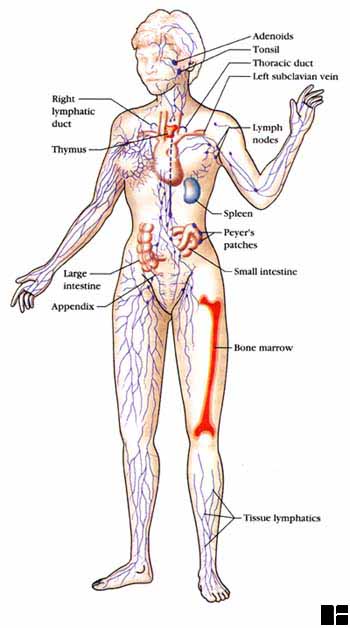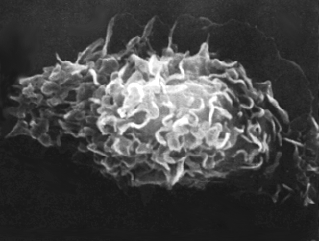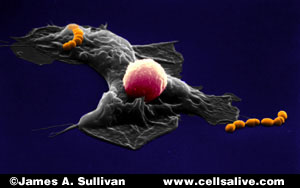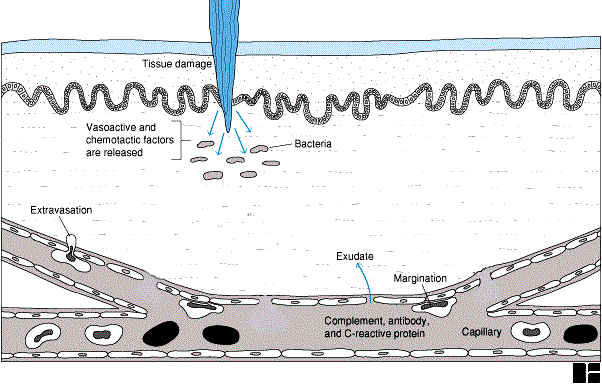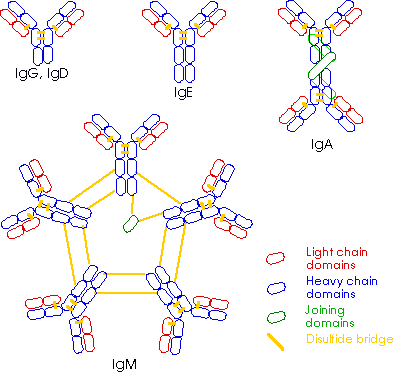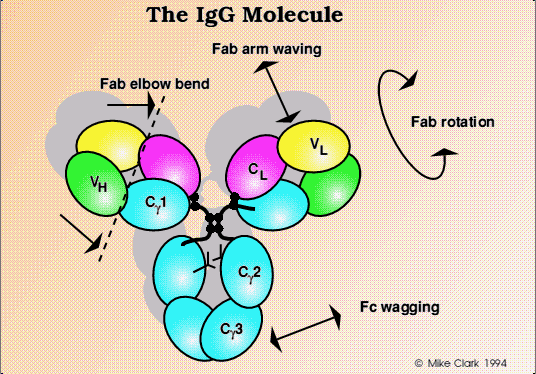|
Surface Barriers or Mucosal Immunity Terms the student should know are in blue. The human immune system is a truly amazing constellation of responses to attacks from outside the body. It has many facets, a number of which can change to optimize the response to these unwanted intrusions. The system is remarkably effective, most of the time. This note will give you a brief outline of some of the processes involved. An antigen is any substance that elicits an immune response, from a virus to a sliver. The immune system has a series of dual natures, the most important of which is self/non-self recognition. The others are: general/specific, natural/adaptive = innate/acquired, cell-mediated/humoral, active/passive, primary/secondary. Parts of the immune system are antigen-specific (they recognize and act against particular antigens), systemic (not confined to the initial infection site, but work throughout the body), and have memory (recognize and mount an even stronger attack to the same antigen the next time). Self/non-self recognition is achieved by having every cell display a marker based on the major histocompatibility complex (MHC). Any cell not displaying this marker is treated as non-self and attacked. The process is so effective that undigested proteins are treated as antigens. Sometimes the process breaks down and the immune system attacks self-cells. This is the case of autoimmune diseases like multiple sclerosis, systemic lupus erythematosus, and some forms of arthritis and diabetes. There are cases where the immune response to innocuous substances is inappropriate. This is the case of allergies and the simple substance that elicits the response is called an allergen. There are two main fluid systems in the body: blood and lymph. The blood and lymph systems are intertwined throughout the body and they are responsible for transporting the agents of the immune system. The 5 liters of blood of a 70 kg (154 lb) person constitute about 7% of the body's total weight. The blood flows from the heart into arteries, then to capillaries, and returns to the heart through veins. Blood is composed of 52–62% liquid plasma and 38–48% cells. The plasma is mostly water (91.5%) and acts as a solvent for transporting other materials (7% protein [consisting of albumins (54%), globulins (38%), fibrinogen (7%), and assorted other stuff (1%)] and 1.5% other stuff). Blood is slightly alkaline (pH = 7.40 ± .05) and a tad heavier than water (density = 1.057 ± .009). All blood cells are manufactured by stem cells, which live mainly in the bone marrow, via a process called hematopoiesis. The stem cells produce hemocytoblasts that differentiate into the precursors for all the different types of blood cells. Hemocytoblasts mature into three types of blood cells: erythrocytes (red blood cells or RBCs), leukocytes (white blood cells or WBCs), and thrombocytes (platelets). The leukocytes are further subdivided into granulocytes (containing large granules in the cytoplasm) and agranulocytes (without granules). The granulocytes consist of neutrophils (55–70%), eosinophils (1–3%), and basophils (0.5–1.0%). The agranulocytes are lymphocytes (consisting of B cells and T cells) and monocytes. Lymphocytes circulate in the blood and lymph systems, and make their home in the lymphoid organs. All of the major cells in the blood system are illustrated below. There are 5000–10,000 WBCs per mm3 and they live 5-9 days. About 2,400,000 RBCs are produced each second and each lives for about 120 days (They migrate to the spleen to die. Once there, that organ scavenges usable proteins from their carcasses). A healthy male has about 5 million RBCs per mm3, whereas females have a bit fewer than 5 million.
The goo on RBCs is responsible for the usual ABO blood grouping, among other things. The grouping is characterized by the presence or absence of A and/or B antigens on the surface of the RBCs. Blood type AB means both antigens are present and type O means both antigens are absent. Type A blood has A antigens and type B blood has B antigens. Some of the blood, but not red blood cells (RBCs), is pushed through the capillaries into the interstitial fluid. Lymph is an alkaline (pH > 7.0) fluid that is usually clear, transparent, and colorless. It flows in the lymphatic vessels and bathes tissues and organs in its protective covering. There are no RBCs in lymph and it has a lower protein content than blood. Like blood, it is slightly heavier than water (density = 1.019 ± .003). The lymph flows from the interstitial fluid through lymphatic vessels up to either the thoracic duct or right lymph duct, which terminate in the subclavian veins, where lymph is mixed into the blood. (The right lymph duct drains the right sides of the thorax, neck, and head, whereas the thoracic duct drains the rest of the body.) Lymph carries lipids and lipid-soluble vitamins absorbed from the gastrointestinal (GI) tract. Since there is no active pump in the lymph system, there is no back-pressure produced. The lymphatic vessels, like veins, have one-way valves that prevent backflow. Additionally, along these vessels there are small bean-shaped lymph nodes that serve as filters of the lymphatic fluid. It is in the lymph nodes where antigen is usually presented to the immune system. The human lymphoid system has the following: · primary organs: bone marrow (in the hollow center of bones) and the thymus gland (located behind the breastbone above the heart), and · secondary organs at or near possible portals of entry for pathogens: adenoids, tonsils, spleen (located at the upper left of the abdomen), lymph nodes (along the lymphatic vessels with concentrations in the neck, armpits, abdomen, and groin), Peyer's patches (within the intestines), and the appendix. The innate immunity system is what we are born with and it is nonspecific; all antigens are attacked pretty much equally. It is genetically based and we pass it on to our offspring. Surface Barriers or Mucosal Immunity
Normal flora are the microbes, mostly bacteria, that live in and on the body with, usually, no harmful effects to us. We have about 1013 cells in our bodies and 1014 bacteria, most of which live in the large intestine. There are 103–104 microbes per cm2 on the skin (Staphylococcus aureus, Staph. epidermidis, diphtheroids, streptococci, Candida, etc.). Various bacteria live in the nose and mouth. Lactobacilli live in the stomach and small intestine. The upper intestine has about 104 bacteria per gram; the large bowel has 1011 per gram, of which 95–99% are anaerobes (An anaerobe is a microorganism that can live without oxygen, while an aerobe requires oxygen.) or bacteroides. The urogenitary tract is lightly colonized by various bacteria and diphtheroids. After puberty, the vagina is colonized by Lactobacillus aerophilus that ferment glycogen to maintain an acid pH. Normal flora fill almost all of the available ecological niches in the body and produce bacteriocidins, defensins, cationic proteins, and lactoferrin all of which work to destroy other bacteria that compete for their niche in the body. The resident bacteria can become problematic when they invade spaces in which they were not meant to be. As examples: (a) staphylococcus living on the skin can gain entry to the body through small cuts/nicks. (b) Some antibiotics, in particular clindamycin, kill some of the bacteria in our intestinal tract. This causes an overgrowth of Clostridium difficile, which results in pseudomembranous colitis, a rather painful condition wherein the inner lining of the intestine cracks and bleeds. A phagocyte is a cell that attracts (by chemotaxis), adheres to, engulfs, and ingests foreign bodies. Promonocytes are made in the bone marrow, after which they are released into the blood and called circulating monocytes, which eventually mature into macrophages (meaning "big eaters", see below). Some macrophages are concentrated in the lungs, liver (Kupffer cells), lining of the lymph nodes and spleen, brain microglia, kidney mesoangial cells, synovial A cells, and osteoclasts. They are long-lived, depend on mitochondria for energy, and are best at attacking dead cells and pathogens capable of living within cells. Once a macrophage phagocytizes a cell, it places some of its proteins, called epitopes, on its surface—much like a fighter plane displaying its hits. These surface markers serve as an alarm to other immune cells that then infer the form of the invader. All cells that do this are called antigen presenting cells (APCs). The non-fixed or wandering macrophages roam the blood vessels and can even leave them to go to an infection site where they destroy dead tissue and pathogens. Emigration by squeezing through the capillary walls to the tissue is called diapedesis or extravasation. The presence of histamines at the infection site attract the cells to their source. Natural killer cells move in the blood and lymph to lyse (cause to burst) cancer cells and virus-infected body cells. They are large granular lymphocytes that attach to the glycoproteins on the surfaces of infected cells and kill them. Polymorphonuclear neutrophils, also called polys for short, are phagocytes that have no mitochondria and get their energy from stored glycogen. They are nondividing, short-lived (half-life of 6–8 hours, 1–4 day lifespan), and have a segmented nucleus. [The picture below shows the neutrophil phagocytizing bacteria, in yellow.] They constitute 50–75% of all leukocytes. The neutrophils provide the major defense against pyogenic (pus-forming) bacteria and are the first on the scene to fight infection. They are followed by the wandering macrophages about three to four hours later. The complement system is a major triggered enzyme plasma system. It coats microbes with molecules that make them more susceptible to engulfment by phagocytes. Vascular permeability mediators increase the permeability of the capillaries to allow more plasma and complement fluid to flow to the site of infection. They also encourage polys to adhere to the walls of capillaries (margination) from which they can squeeze through in a matter of minutes to arrive at a damaged area. Once phagocytes do their job, they die and their "corpses," pockets of damaged tissue, and fluid form pus. Eosinophils are attracted to cells coated with complement C3B, where they release major basic protein (MBP), cationic protein, perforins, and oxygen metabolites, all of which work together to burn holes in cells and helminths (worms). About 13% of the WBCs are eosinophils. Their lifespan is about 8–12 days. Neutrophils, eosinophils, and macrophages are all phagocytes. Dendritic cells are covered with a maze of membranous processes that look like nerve cell dendrites. Most of them are highly efficient antigen presenting cells. There are four basic types: Langerhans cells, interstitial dendritic cells, interdigitating dendritic cells, and circulating dendritic cells. Our major concern will be Langerhans cells, which are found in the epidermis and mucous membranes, especially in the anal, vaginal, and oral cavities. These cells make a point of attracting antigen and efficiently presenting it to T helper cells for their activation. [This accounts, in part, for the transmission of HIV via sexual contact.] Each of the cells in the innate immune system bind to antigen using pattern-recognition receptors. These receptors are encoded in the germ line of each person. This immunity is passed from generation to generation. Over the course of human development these receptors for pathogen-associated molecular patterns have evolved via natural selection to be specific to certain characteristics of broad classes of infectious organisms. There are several hundred of these receptors and they recognize patterns of bacterial lipopolysaccharide, peptidoglycan, bacterial DNA, dsRNA, and other substances. Clearly, they are set to target both Gram-negative and Gram-positive bacteria. Lymphocytes come in two major types: B cells and T cells. The peripheral blood contains 20–50% of circulating lymphocytes; the rest move in the lymph system. Roughly 80% of them are T cells, 15% B cells and remainder are null or undifferentiated cells. Lymphocytes constitute 20–40% of the body's WBCs. Their total mass is about the same as that of the brain or liver. (Heavy stuff!) B cells are produced in the stem cells of the bone marrow; they produce antibody and oversee humoral immunity. T cells are nonantibody-producing lymphocytes which are also produced in the bone marrow but sensitized in the thymus and constitute the basis of cell-mediated immunity. The production of these cells is diagrammed below. Parts of the immune system are changeable and can adapt to better attack the invading antigen. There are two fundamental adaptive mechanisms: cell-mediated immunity and humoral immunity. Macrophages engulf antigens, process them internally, then display parts of them on their surface together with some of their own proteins. This sensitizes the T cells to recognize these antigens. All cells are coated with various substances. CD stands for cluster of differentiation and there are more than one hundred and sixty clusters, each of which is a different chemical molecule that coats the surface. CD8+ is read "CD8 positive." Every T and B cell has about 105 = 100,000 molecules on its surface. B cells are coated with CD21, CD35, CD40, and CD45 in addition to other non-CD molecules. T cells have CD2, CD3, CD4, CD28, CD45R, and other non-CD molecules on their surfaces. The large number of molecules on the surfaces of lymphocytes allows huge variability in the forms of the receptors. They are produced with random configurations on their surfaces. There are some 1018 different structurally different receptors. Essentially, an antigen may find a near-perfect fit with a very small number of lymphocytes, perhaps as few as one. T cells are primed in the thymus, where they undergo two selection processes. The first positive selection process weeds out only those T cells with the correct set of receptors that can recognize the MHC molecules responsible for self-recognition. Then a negative selection process begins whereby T cells that can recognize MHC molecules complexed with foreign peptides are allowed to pass out of the thymus. Cytotoxic or killer T cells (CD8+) do their work by releasing lymphotoxins, which cause cell lysis. Helper T cells (CD4+) serve as managers, directing the immune response. They secrete chemicals called lymphokines that stimulate cytotoxic T cells and B cells to grow and divide, attract neutrophils, and enhance the ability of macrophages to engulf and destroy microbes. Suppressor T cells inhibit the production of cytotoxic T cells once they are unneeded, lest they cause more damage than necessary. Memory T cells are programmed to recognize and respond to a pathogen once it has invaded and been repelled. An immunocompetent but as yet immature B-lymphocyte is stimulated to maturity when an antigen binds to its surface receptors and there is a T helper cell nearby (to release a cytokine). This sensitizes or primes the B cell and it undergoes clonal selection, which means it reproduces asexually by mitosis. Most of the family of clones become plasma cells. These cells, after an initial lag, produce highly specific antibodies at a rate of as many as 2000 molecules per second for four to five days. The other B cells become long-lived memory cells. Antibodies, also called immunoglobulins or Igs [with molecular weights of 150–900 Md], constitute the gamma globulin part of the blood proteins. They are soluble proteins secreted by the plasma offspring (clones) of primed B cells. The antibodies inactivate antigens by, (a) complement fixation (proteins attach to antigen surface and cause holes to form, i.e., cell lysis), (b) neutralization (binding to specific sites to prevent attachment—this is the same as taking their parking space), (c) agglutination (clumping), (d) precipitation (forcing insolubility and settling out of solution), and other more arcane methods. Constituents of gamma globulin are: IgG-76%, IgA-15%, IgM-8%, IgD-1%, and IgE-0.002% (responsible for autoimmune responses, such as allergies and diseases like arthritis, multiple sclerosis, and systemic lupus erythematosus). IgG is the only antibody that can cross the placental barrier to the fetus and it is responsible for the 3 to 6 month immune protection of newborns that is conferred by the mother. IgM is the dominant antibody produced in primary immune responses, while IgG dominates in secondary immune responses. IgM is physically much larger than the other immunoglobulins. Notice the many degrees of flexibility of the antibody molecule. This freedom of movement allows it to more easily conform to the nooks and crannies on an antigen. The upper part or Fab (antigen binding) portion of the antibody molecule (physically and not necessarily chemically) attaches to specific proteins [called epitopes] on the antigen. Thus antibody recognizes the epitope and not the entire antigen. The Fc region is crystallizable and is responsible for effector functions, i.e., the end to which immune cells can attach. Lest you think that these are the only forms of antibody produced, you should realize that the B cells can produce as many as 1014 conformationally different forms. The process by which T cells and B cells interact with antigens is summarized in the diagram below. In the ABO blood typing system, when an A antigen is present (in a person of blood type A), the body produces an anti-B antibody, and similarly for a B antigen. The blood of someone of type AB, has both antigens, hence has neither antibody. Thus that person can be transfused with any type of blood, since there is no antibody to attack foreign blood antigens. A person of blood type O has neither antigen but both antibodies and cannot receive AB, A, or B type blood, but they can donate blood for use by anybody. If someone with blood type A received blood of type B, the body's anti-B antibodies would attack the new blood cells and death would be imminent. All of these of these mechanisms hinge on the attachment of antigen and cell receptors. Since there are many, many receptor shapes available, WBCs seek to optimize the degree of confluence between the two receptors. The number of these "best fit" receptors may be quite small, even as few as a single cell. This attests to the specificity of the interaction. Nevertheless, cells can bind to receptors whose fit is less than optimal when required. This is referred to as cross-reactivity. Cross-reactivity has its limits. There are many receptors to which virions cannot possibly bind. Very few viruses can bind to skin cells. The design of immunizing vaccines hinges on the specificity and cross-reactivity of these bonds. The more specific the bond, the more effective and long-lived the vaccine. The smallpox vaccine, which is made from the vaccinia virus that causes cowpox, is a very good match for the smallpox receptors. Hence, that vaccine is 100% effective and provides immunity for about 20 years. Vaccines for cholera have a relatively poor fit so they do not protect against all forms of the disease and protect for less than a year. The goal of all vaccines is promote a primary immune reaction so that when the organism is again exposed to the antigen, a much stronger secondary immune response will be elicited. Any subsequent immune response to an antigen is called a secondary response and it has
Immunity can be either natural or artificial, innate or acquired=adaptive, and either active or passive.
Objectives Know: antigen, overall properties of the immune system, allergen; major fluid systems of the body; hematopoiesis occurs in stem cells of the bone; erythrocytes, leukocytes, and thrombocytes; types of white blood cells; lymphoid system and lymph nodes; mucosal immunity and types of surface barriers to infection; normal flora; phagocytes, macrophages, antigen presenting cells, neutrophils, B cells and T cells are produced in the bone marrow and T cells are primed in the thymus, CD4+ and CD8+ cells, helper cells, memory cells, cytotoxic cells, suppressor cells; priming and clonal selection; antibody and Igs; differences between identifying self and non-self, innate and acquired immunity, primary and secondary immunity, active and passive immunity; specificity and cross-reactivity. |
||||||||||||||||||||||||||||||||||||

